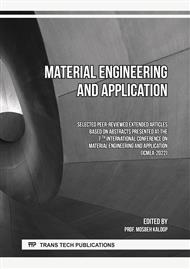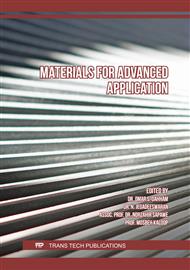[1]
M. Sarno and M. Iuliano, Biodiesel production from waste cooking oil, Green Processing and Synthesis 8 (1) (2019) 828–836.
DOI: 10.1515/gps-2019-0053
Google Scholar
[2]
Sahar et al., Biodiesel production from waste cooking oil: An efficient technique to convert waste into biodiesel, Sustainable Cities and Society 41 (2018) 220-226.
DOI: 10.1016/j.scs.2018.05.037
Google Scholar
[3]
H. Bateni, A. Saraeian, and C. Able, A comprehensive review on biodiesel purification and upgrading, Biofuel Research Journal 4 (3) (2017) 668–690.
DOI: 10.18331/brj2017.4.3.5
Google Scholar
[4]
I. M. Atadashi, Purification of crude biodiesel using dry washing and membrane technologies, Alexandria Engineering Journal 54 (4) (2015) 1265–1272.
DOI: 10.1016/j.aej.2015.08.005
Google Scholar
[5]
V. Cordero-Ravelo and J. Schallenberg-Rodriguez, Biodiesel production as a solution to waste cooking oil (WCO) disposal. Will any type of WCO do for a transesterification process? A quality assessment, Journal of Environmental Management 228 (2018) 117–129.
DOI: 10.1016/j.jenvman.2018.08.106
Google Scholar
[6]
F. Salmanizade, A. Ghazanfari Moghaddam, and A. Mohebbi, Improvement hydrocyclone separation of biodiesel impurities prepared from waste cooking oil using CFD simulation, Separation Science and Technology (Philadelphia) 56 (6) (2021) 1152–1167.
DOI: 10.1080/01496395.2020.1749081
Google Scholar
[7]
M. Abdul Raqeeb, Biodiesel production from waste cooking oil, Journal of Chemical and Pharmaceutical Research 7 (12) (2015) 670–681.
Google Scholar
[8]
A. Williams, R. McCormick, M. Lance, C. Xie, T. Toops, and R. Brezny, Effect of Accelerated Aging Rate on the Capture of Fuel-Borne Metal Impurities by Emissions Control Devices, SAE International Journal of Fuels and Lubricants 7 (2) (2014) 471–479.
DOI: 10.4271/2014-01-1500
Google Scholar
[9]
J. Wall, J. van Gerpen, and J. Thompson, Soap and glycerin removal from biodiesel using waterless processes, Transactions of the ASABE 54 (2) 535–541.
DOI: 10.13031/2013.36456
Google Scholar
[10]
P. Assawasaengrat, P. Jintanavasan, and P. Kitchaiya, Adsorption of FFA, soap and glycerine in biodiesel using magnesium silicate, Chemical Engineering Transactions 43 (2015) 1135–1140.
Google Scholar
[11]
W. P. Silvestre, F. R. Medeiros, F. Agostini, D. Toss, and G. F. Pauletti, Fractionation of rosemary (Rosmarinus officinalis L.) essential oil using vacuum fractional distillation, Journal of Food Science and Technology 56 (12) (2019) 5422–5434.
DOI: 10.1007/s13197-019-04013-z
Google Scholar
[12]
S. Lorefice, R. Romeo, M. Santiano, and A. Capelli, Original pycnometers for volatile liquid density over wide ranges of temperature and pressure: Practical example, Metrologia 51 (3) (2014) 154–160.
DOI: 10.1088/0026-1394/51/3/154
Google Scholar
[13]
M. Gülüm and A. Bilgin, Regression Models for Predicting Some Important Fuel Properties of Corn and Hazelnut Oil Biodiesel-Diesel Fuel Blends, Exergetic, Energetic and Environmental Dimensions (2018) 829–850.
DOI: 10.1016/b978-0-12-813734-5.00047-0
Google Scholar
[14]
B. M. Mckenna and J. G. Lyng, Principles of food viscosity analysis, Instrumental Assessment of Food Sensory Quality (2013) 129–162.
DOI: 10.1533/9780857098856.1.129
Google Scholar
[15]
V. Thangarasu and R. Anand, Physicochemical fuel properties and tribological behavior of aegle marmelos correa biodiesel, Advances in Eco-Fuels for a Sustainable Environment (2019) 309–336.
DOI: 10.1016/b978-0-08-102728-8.00011-5
Google Scholar
[16]
R. Karmakar, K. Kundu, and A. Rajor, Fuel properties and emission characteristics of biodiesel produced from unused algae grown in India, Petroleum Science 15 (2) (2018) 385–395.
DOI: 10.1007/s12182-017-0209-7
Google Scholar
[17]
M. J. Pratas, S. V. D. Freitas, M. B. Oliveira, S. C. Monteiro, Á. S. Lima, and J. A. P. Coutinho, Biodiesel Density: Experimental Measurements and Prediction Models, Energy & Fuels 25 (5) (2011) 2333–2340.
DOI: 10.1021/ef2002124
Google Scholar
[18]
S. Phankosol, K. Sudaprasert, S. Lilitchan, K. Aryusuk, and K. Krisnangkura, Estimation of Density of Biodiesel, Energy & Fuels 28 (7) (2014) 4633–4641.
DOI: 10.1021/ef501031z
Google Scholar
[19]
G. Knothe and L. F. Razon, Biodiesel fuels, Progress in Energy and Combustion Science 58 (2017) 36–59.
DOI: 10.1016/j.pecs.2016.08.001
Google Scholar
[20]
D. Babu and R. Anand, Influence of fuel injection timing and nozzle opening pressure on a CRDI-assisted diesel engine fueled with biodiesel-diesel-alcohol fuel, Advances in Eco-Fuels for a Sustainable Environment (2019) 353–390.
DOI: 10.1016/b978-0-08-102728-8.00013-9
Google Scholar
[21]
V. Thangarasu and R. Anand, Physicochemical fuel properties and tribological behavior of aegle marmelos correa biodiesel, Advances in Eco-Fuels for a Sustainable Environment (2019) 309–336.
DOI: 10.1016/b978-0-08-102728-8.00011-5
Google Scholar
[22]
J. Isac-García, J. A. Dobado, F. G. Calvo-Flores, and H. Martínez-García, Determining Physical and Spectroscopic Properties, Experimental Organic Chemistry (2016) 145–175.
DOI: 10.1016/b978-0-12-803893-2.50005-x
Google Scholar
[23]
Testing Biodiesel For Soap Content, Utah Biodiesel Supply Blog, http://www.utahbiodieselsupply.com/blog/testing-biodiesel-for-soap-content/ (2011).
Google Scholar
[24]
P. B. L. Fregolente, L. V. Fregolente, and M. R. Wolf Maciel, Water Content in Biodiesel, Diesel, and Biodiesel–Diesel Blends, Journal of Chemical & Engineering Data 57 (6) (2012) 1817–1821.
DOI: 10.1021/je300279c
Google Scholar
[25]
T. Sokač, M. Gojun, A. J. Tušek, A. Šalić, and B. Zelić, Purification of biodiesel produced by lipase catalysed transesterification by ultrafiltration: Selection of membranes and analysis of membrane blocking mechanisms, Renewable Energy 159 (2020) 642–651.
DOI: 10.1016/j.renene.2020.05.132
Google Scholar
[26]
P. V. Rao and D. P. Chary, Characteristics comparison of Biodiesel-Diesel Blend (B20) Fuel with Alcohol Additives, International Journal of Advanced Engineering Research and Science 5 (8) (2018) 128–132.
DOI: 10.22161/ijaers.5.8.17
Google Scholar



